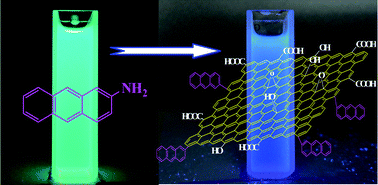Novel blue light emitting graphene oxide nanosheets fabricated by surface functionalization
Abstract

* Corresponding authors
a
State Key Laboratory of Electroanalytical Chemistry, Changchun Institute of Applied Chemistry, Chinese Academy of Sciences, Changchun, China
E-mail:
weichen@ciac.jl.cn
Tel: (+86)431-85262061
b Graduate School of the Chinese Academy of Sciences, Beijing, China
c Changchun University of Science and Technology, Changchun, Jilin, China

 Please wait while we load your content...
Something went wrong. Try again?
Please wait while we load your content...
Something went wrong. Try again?
Y. Lu, Y. Jiang, W. Wei, H. Wu, M. Liu, L. Niu and W. Chen, J. Mater. Chem., 2012, 22, 2929 DOI: 10.1039/C1JM14174K
To request permission to reproduce material from this article, please go to the Copyright Clearance Center request page.
If you are an author contributing to an RSC publication, you do not need to request permission provided correct acknowledgement is given.
If you are the author of this article, you do not need to request permission to reproduce figures and diagrams provided correct acknowledgement is given. If you want to reproduce the whole article in a third-party publication (excluding your thesis/dissertation for which permission is not required) please go to the Copyright Clearance Center request page.
Read more about how to correctly acknowledge RSC content.
 Fetching data from CrossRef.
Fetching data from CrossRef.
This may take some time to load.
Loading related content
